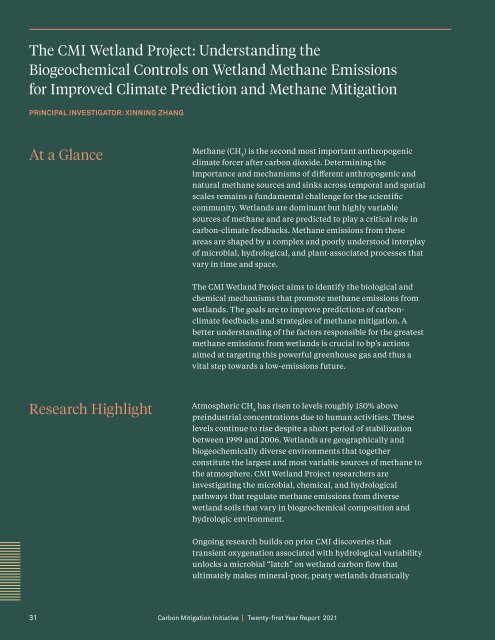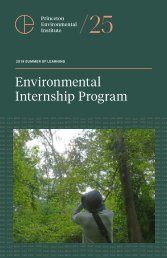CMI Annual Report 2021
Create successful ePaper yourself
Turn your PDF publications into a flip-book with our unique Google optimized e-Paper software.
The <strong>CMI</strong> Wetland Project: Understanding the<br />
Biogeochemical Controls on Wetland Methane Emissions<br />
for Improved Climate Prediction and Methane Mitigation<br />
PRINCIPAL INVESTIGATOR: XINNING ZHANG<br />
At a Glance<br />
Methane (CH 4<br />
) is the second most important anthropogenic<br />
climate forcer after carbon dioxide. Determining the<br />
importance and mechanisms of different anthropogenic and<br />
natural methane sources and sinks across temporal and spatial<br />
scales remains a fundamental challenge for the scientific<br />
community. Wetlands are dominant but highly variable<br />
sources of methane and are predicted to play a critical role in<br />
carbon-climate feedbacks. Methane emissions from these<br />
areas are shaped by a complex and poorly understood interplay<br />
of microbial, hydrological, and plant-associated processes that<br />
vary in time and space.<br />
The <strong>CMI</strong> Wetland Project aims to identify the biological and<br />
chemical mechanisms that promote methane emissions from<br />
wetlands. The goals are to improve predictions of carbonclimate<br />
feedbacks and strategies of methane mitigation. A<br />
better understanding of the factors responsible for the greatest<br />
methane emissions from wetlands is crucial to bp’s actions<br />
aimed at targeting this powerful greenhouse gas and thus a<br />
vital step towards a low-emissions future.<br />
Research Highlight<br />
Atmospheric CH 4<br />
has risen to levels roughly 150% above<br />
preindustrial concentrations due to human activities. These<br />
levels continue to rise despite a short period of stabilization<br />
between 1999 and 2006. Wetlands are geographically and<br />
biogeochemically diverse environments that together<br />
constitute the largest and most variable sources of methane to<br />
the atmosphere. <strong>CMI</strong> Wetland Project researchers are<br />
investigating the microbial, chemical, and hydrological<br />
pathways that regulate methane emissions from diverse<br />
wetland soils that vary in biogeochemical composition and<br />
hydrologic environment.<br />
Ongoing research builds on prior <strong>CMI</strong> discoveries that<br />
transient oxygenation associated with hydrological variability<br />
unlocks a microbial “latch” on wetland carbon flow that<br />
ultimately makes mineral-poor, peaty wetlands drastically<br />
31<br />
Carbon Mitigation Initiative Twenty-first Year <strong>Report</strong> <strong>2021</strong>
















